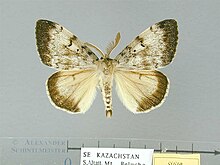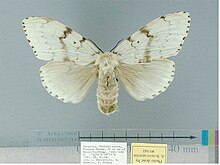Lymantria dispar asiatica
| Asian gypsy moth | |
|---|---|
 |
|
| Mounted male | |
 |
|
| Mounted female | |
| Scientific classification | |
| Kingdom: | Animalia |
| Phylum: | Arthropoda |
| Class: | Insecta |
| Order: | Lepidoptera |
| Family: | Erebidae |
| Subfamily: | Lymantriinae |
| Tribe: | Lymantriini |
| Subtribe: | Lymantriina |
| Genus: | Lymantria |
| Species: | Lymantria dispar |
| Subspecies: | L. d. asiatica |
| Trinomial name | |
|
Lymantria dispar asiatica Vnukovskij, 1926 |
|
The Asian gypsy moth, Lymantria dispar asiatica, is a moth in the family Erebidae of Eurasian origin. It is similar to Lymantria dispar dispar in appearance, but adult females are flight-capable. It is classified as a pest and is host to over 500 species of trees, shrubs and plants.
Lymantria dispar asiatica has several common names including the Asian Gypsy Moth, Persimmon caterpillar or Persimmon tussock moth.
Lymantria dispar asiatica was originally described as a subspecies of Lymantria dispar by Vnukovskij in 1926. It was synonymized with Lymantria dispar dispar by Schintlmeister in 2004.L. d. asiatica is treated as a subspecies of 'L. dispar'.
The species has undergone the same reclassification of the family as Lymantria dispar, moving from Lymantriidae to Noctuidae to Erebidae.
Found throughout temperate Asia. Usually east of the Ural Mountains into up into far east of Russia, the most of China and Korea. It is not found south of the Himalayan range in India.
Lymantria dispar asiatica was found in North America in late 1991. It was first found in British Columbia, Canada. It also was found in Washington and Oregon, United States. Transportation was suspected to have been from ships from Russia that had become infested with egg masses, with the eggs having been hatched and the larvae then blown ashore. This infestation was eradicated. It reappeared in Washington in 1997 and was found in Oregon in 2000. It was reported that these infestations were eradicated in 2005.
It was also found in North Carolina in 1997, the transportation having been from shipping cargo containers from Germany. This infestation was eradicated.
Lymantria dispar asiatica has four stages of life: egg, larvae, pupae and moth.
The adult female moth is dirty- to creamy-white, with dark bands across the forewings. The hindwings are white. The female's body is stout and densely covered with hairs, and the antennae are dark brown and thread-like.
The adult male moth is smaller than the female moth, and the wings are dark brown with black bands across the forewings. The hindwings are brown and may possess a crescent-shaped discal spot. Its head's front vertex and scape are light brown. The antennae are light brown and feathery.
Adult moths are incapable of eating: the adult only mates and lays eggs. Adult moths will die within one to three weeks after emerging.
Eggs are laid in clusters that are about the size of a dime. The eggs are dormant during the winter. Larvae will hatch from the eggs in the spring.
In China and Korea, egg masses are placed high up on the under-surfaces of branches of large pine trees. In Russia and Mongolia, eggs are laid on rock outcrops or on the soil under boulders. Egg masses are laid on top of other egg masses or the remains of previous years' egg masses. In far eastern Russia, egg masses are laid on undersides of leaves of deciduous trees. When the leaves fall, the eggs are covered with snow and become insulated from temperatures which would otherwise kill them.
...
Wikipedia
